Sony FE 90mm f/2.8 G OSS Macro lens review

In the last few weeks I’ve found myself replying to Facebook Sony user group posts where new owners building their systems have asked about the Sony 90mm f/2.8 G OSS Macro FE lens. Over the months before this, I’d seen so many comments saying this was the best ever Sony and perhaps the second best lens ever.

While the world has been raving about the 90mm since 2015, I had not used it – I am not on any list to get new lenses to look at. But I have used macro lenses of this focal length (or close) for years. I continued to weigh up whether to replace my well-trusted Sony SAL 100mm f/2.8 Macro A-mount, which for two years had been used with manual focus only on the LA-EA3 (above) as I sold my LA-EA4 after selling my 70-210mm f/4, 50mm f/1.4 and 24mm f/2 SSM lenses. The 90mm is a very different kind of lens, using purely internal focusing rather than the long extension seen side by side above.
When testing the Voigtlander 110mm MF 1:1 macro and AF Sony 100mm STF (0.25X scale closest focus) on moving subjects – Butterfly World Edinburgh – the benefits of both 1:1 macro and autofocus became all too clear. I had thought the 1:4 scale of the STF would be enough for flowers and plants, and also subjects like butterflies, but it was not and the benefits of Smooth Transition Focus almost demanded working at the maximum T5.6 aperture.
I loved the Voigtlander’s sharpness, corner to corner, wide open at all distances. Few lenses can ever better an Apo Lanthar Macro. Their 65mm f/2 FE is perfection, and the 110mm f/2.5 proved much the same. Unlike Zeiss Loxia lenses these Voigtlander FE models make proper use of Sony E-mount body functions including 5-Axis stabilisation, focus distance display in the EVF, and instant magnified focus when using the focus barrel.

But the butterflies reminded me why AF is useful on macro even if you lock the focus and move the camera to capture the final shot. AF can get you to the subject distance rapidly without moving your hand to the lens. The Voigtlander uses almost three full rotations of its big focus barrel to go from infinity to 1:1 and even small scale changes mean moving your hand on to the lens and twisting it, often repeatedly. This takes time and can disturb subjects more than the quick ‘zip’ sound of autofocus, or the slower grind of A-mount body-driven AF on the LA-EA4.
Going for the 90mm
So, with my 100mm macro lens an A-mount model only usable in manual focus mode with my LA-EA3 adaptor, I decided to bite the bullet and buy a Sony SEL 90mm ƒ2.8 G OSS. It’s a £900-ish lens so no light purchase to make, and for me it would also have to handle landscape and general photography well. It might even replace my 85mm ƒ1.8. London Camera Exchange had one available, with an £80 cashback offer. I had returned the ex-demo FE 100mm f/2.8 T5.6 G OSS STF which I initially thought might replace my adapted A-mount macro.

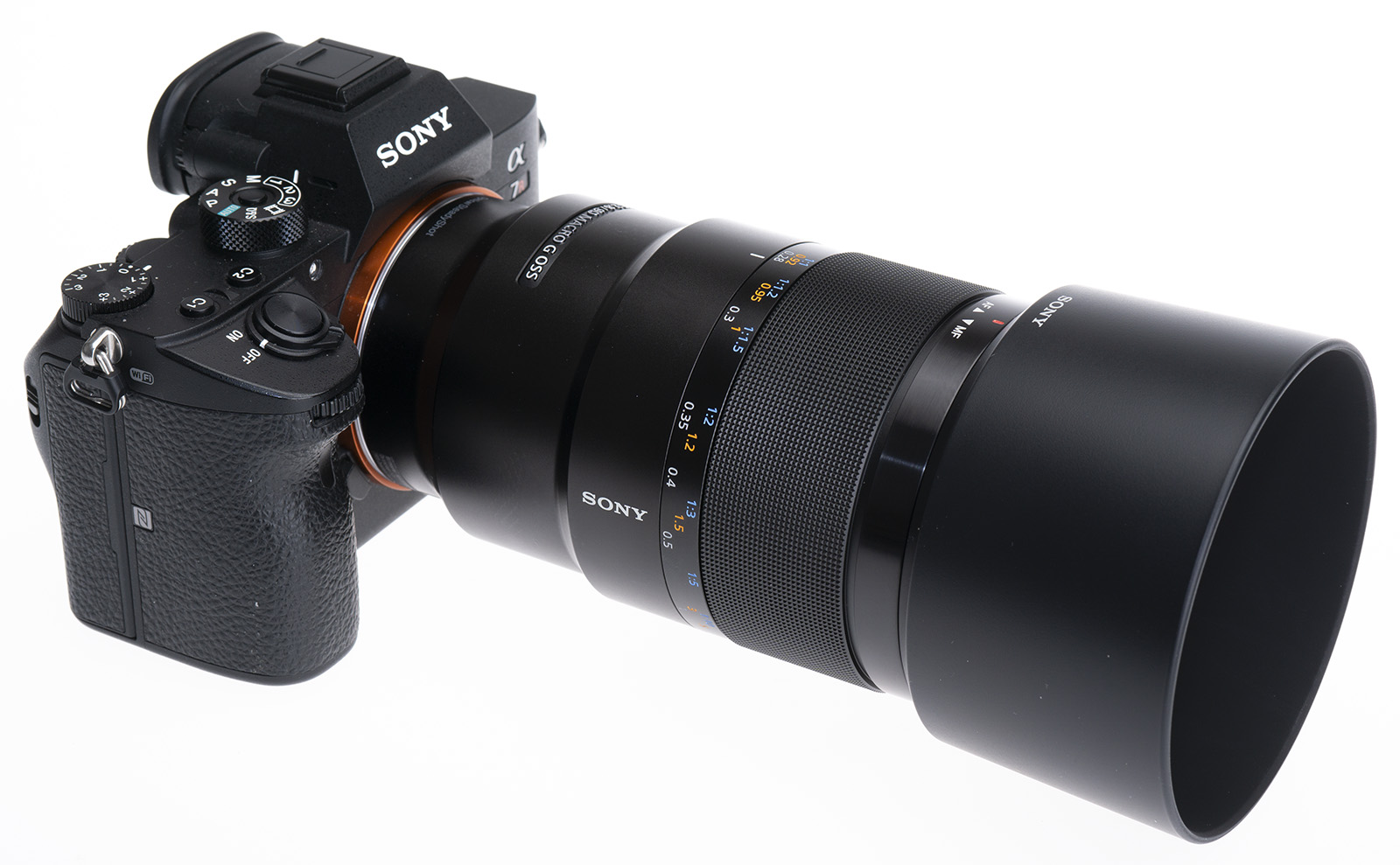
The 90mm came as a replacement. It’s a very well designed lens, and my subsequent testing of Sigma’s 70mm showed how neat it is, as the 70mm with hood is pretty much the same size at the 90mm with hood. It uses internal focusing and does not extend, but keeps a respectable clearance between lens and subject (see Working Distance section below). It’s not as good in this respect as the old 100mm A-mount design which still sets the working distance standard for the entire industry after 33 years.
I only needed a brief trial of the 90mm on the camera for warning bells to ring. The very first frame showed a considerable difference between the top left and top right corners in terms of how the out of focus detail was rendered, the left side a smooth normal blur and the right with astigmatic blur (tangential detail sharper than radial, and a generally ‘ragged’ look). Click the paired comparison below to view full size. Flat subject tests, where everything should have been pin-sharp, showed poor resolution centrally and serious blur to one end.
Most surprising, to me, was that on the cropped frame of the A6500 where this is an ideal macro lens (24MP resolution, virtual 1.5X scale) the blur to the ends of the frame was still there. I shot some landscapes and found that parts of the view were inexplicably unsharp when they should have been within depth of field and matched other areas in sharpness.




This lens went back promptly and James at LCE Colchester (being incredibly helpful when faced with a very critical buyer) got a new lens into stock, and tested it alongside the returned poor lens. The results he sent to me were certainly much better but it was very difficult to be sure. He agreed the first lens was bad, but wasn’t sure if the second one would meet my standards. He sent me sample raw files and I had doubts, but it was definitely better. So lens number two arrived, and while it was definitely sharper centrally it was soft on the right hand side.
When I photograph a landscape with a row of trees on a ridge, at a moderate aperture like f/4.5 on a top grade lens, I expect the branches to be cleanly rendered whether in focus or out. If they are blurred, at any aperture, I want a clean Gaussian look, good bokeh whether at f/2.8 or f/5.6 or f/16. Astigmatism can smear out of focus detail directionally at all apertures and I don’t like that effect. I’ve worked with the budget price Sony SAM 85mm f/2.8 and that was better bar some correctable CA. I had a Canon 85mm f/1.8 USM on an adaptor, it cost me under £200 (used) and gave lovely clean rendering on landscape views though AF was poor on my adaptor, so it was replaced by the Sony 85mm f/1.8 FE which proved even better.
I made tests on the 90mm with AF and MF, OSS on and OSS off, and no settings consistently gave the clean ‘in or out of focus’ image I am used to from other lenses. Using magnified focus, placing the focus point near the corners and manually focusing through sharpness to blur in front of and behind correct focus. The shifting directional quality of the defocused detail confirmed that this lens, too, was not well centred. On a target with fine horizontal and vertical lines, focusing through it and back showed the lines best focused at different points, with the horizontal detail softening when the vertical was sharpest, and vice-versa.

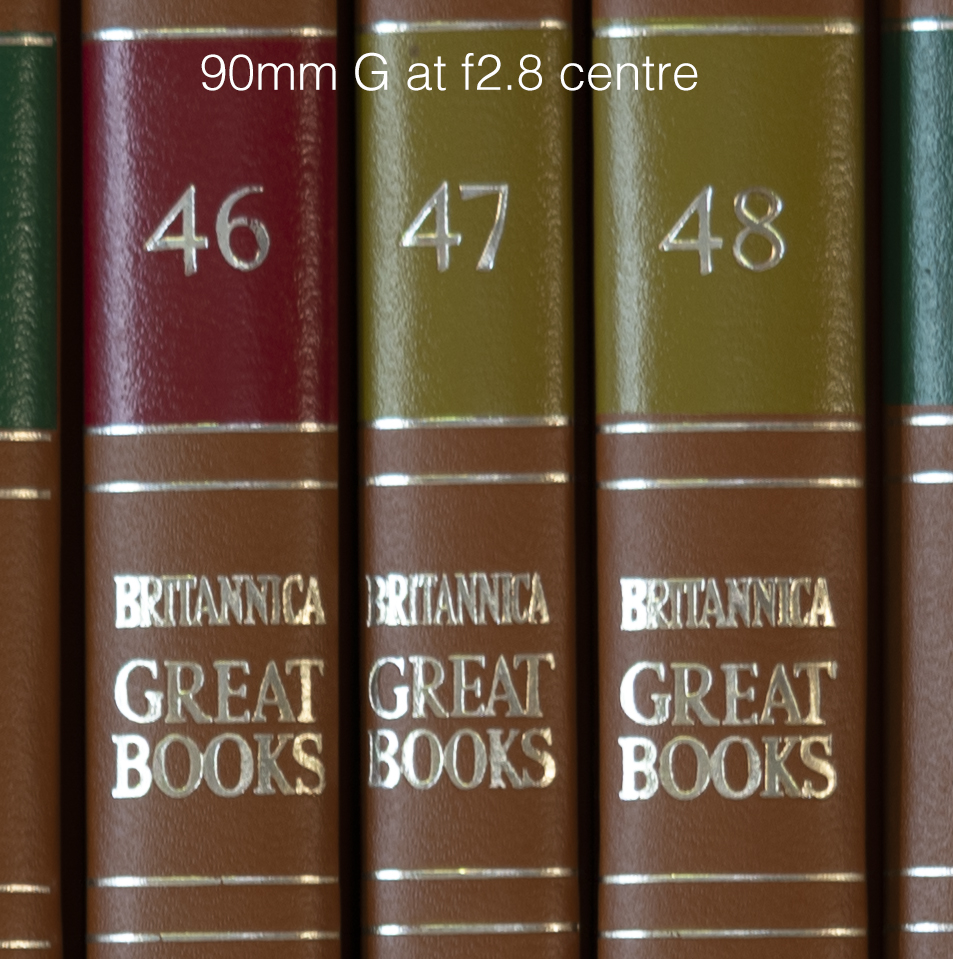

Sony’s publicity claims that every individual 90mm G OSS Macro is tested and fine-tuned for the best performance. The two lenses I had been sent in good faith by the dealer told a different story as one was much better than the other, but neither met expectations. It’s fair to say that had I received the second example originally I would probably have been happy, but after identifying issues with the first one, I was looking critically at the image rendering across the frame, at all apertures, in the plane of focus and also for defocused detail.

Repeating the test on the book-ends, the second lens was as sharp centrally at at the left-hand side as the 85mm, but soft at the right hand side with a similar slightly directional quality to the blurring.

Just to make the point, I also checked my Tamron 28-75mm FE at 75mm and f/2.8 from the same tripod position as the 90mm and 85mm. Centrally it’s very sharp indeed, the edges do lose a bit from field curvature and aberration. But this is a clean blur (extreme left end of frame).

I can only therefore say that on-line reviews and blogs and vlogs which claim the 90mm as one of the sharpest and best lenses made are either written by reviewers who can’t see (or don’t want to see) any problems or got much better lenses. If my two lenses had been perfectly assembled in the Thai factory the good bits of the image tell me that the design is excellent, with minimal CA and LoCA, fast AF and high resolution in the central field.


One negative aspect which better QC would not correct is the strong vignetting at ƒ2.8 which is not eliminated until ƒ8, even with the built-in/Adobe lens profile active. The older 100mm shows vignetting too but not as strong. You might expect a long focal length macro to have almost no vignetting but at landscape distances, many do. They are designed for closer distance use.
I made many tests and will admit to feeling seriously fatigued from aiming lenses at the spines of books from about 1.5m. I did this with the 90mm, with my 85mm f/1.8 Sony FE (even blew the better 90mm away), with my 28-75mm Tamron at 75mm (yes, slightly soft in the corners wide open, but as good centrally as the 90mm’s centre), with the Sigma 70mm f/2.8 Macro (close to perfection) and with my 70-300mm Sony G OSS zoom set to 90mm (slightly soft to the corners but just as sharp in the centre).
Careful observation showed that the corner softness, well-mannered in all these other lenses, was mostly a result of a curved focus field. In the Tamron’s case the corners are focused further away than the centre at 75mm, which can make foreground corners look soft in landscapes. I tend to prefer lenses with a cap-shaped focus plane, so the bottom corners in a room interior or a landscape have improved sharpness. The 90mm also seems to have a slight cup-shaped focus plane. This is typical of lenses or zoom settings which have positive (pincushion) distortion.

But this is all a bit geeky. What mattered to me was that even at apertures like f/5.6 42 megapixels could show poor sharpness towards the ends of the frame and the corners. I want to use a lens like this on landscape and architectural subjects, not only on macro and portraits which are more common examples seen.
Working distance A-mount 100mm versus E-mount 90mm
The 90mm f/2.8 G OSS Macro uses a very advanced internal AF, and like many new AF macro lenses, and does not change barrel length when focused close. The 1986-designed (by Minolta) Sony SAL 100mm f/2.8 Macro also uses hybrid IF and an inset front group to reduce the physical extension to 50mm instead of 100mm at 1:1. During some tests I was comparing the 90mm with this A-mount design manually focused on the LA-EA3 adaptor.
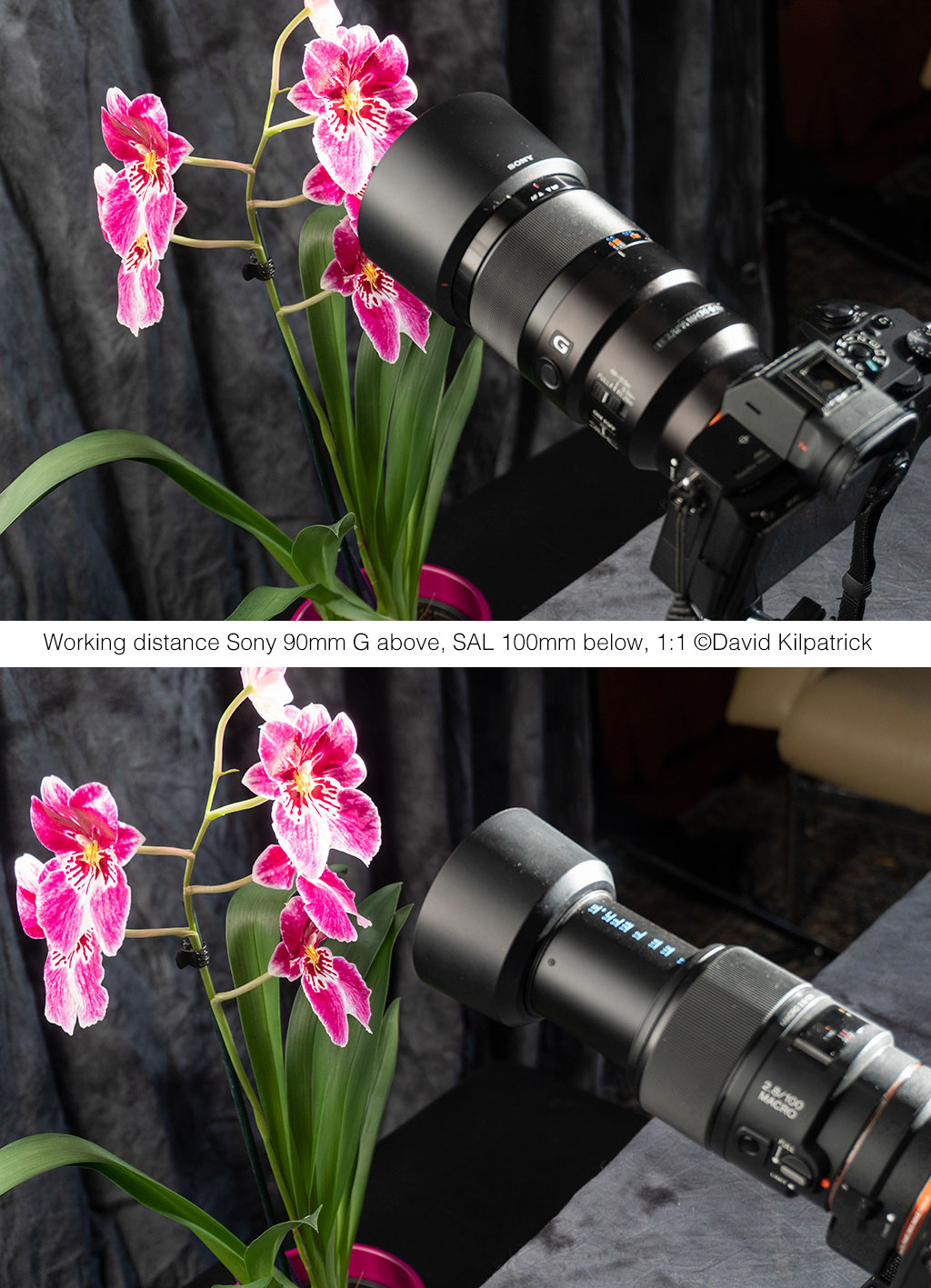
At 1:1, the old-style macro has its front 155mm from the subject. The 90mm is 130mm away, which is not huge difference – 25mm or an inch. The 62mm-fit lens hood, 5mm longer than the A-mount lens’s 55mm hood, adds to the larger barrel diameter. The old lens extends a focusing tube only 58mm in diameter towards the subject. With the hood removed it can get between foliage (etc.) more easily than the 79mm front rim of the 90mm.
The old 100mm focusing tube’s 50mm added extension pushes the camera body and your face and hands further away from the subject – 75mm further than the new lens. If you think this is insignificant, you’ve probably not done much field macro work. It is why 150mm, 180mm and 200mm macro lenses and bellows rigs remain popular. A 100mm lens head on bellows is usually 190 to 200mm away from the subject at 1:1 scale.
On the classic 100mm at infinity the front element is 30mm recessed even before you fit the lens hood (if the ridged lens barrel in front of this element was not present, the working distance would be 185mm). The 90mm G has a larger front element which is up front all the time – remove the lens hood, and it can be exposed to stray light. But it’s much less flare-prone and I never had any problem.


Other aspects of the 90mm are well-designed. The A-mount 100mm has a large ribbed grip focus barrel instead of the small front ring of the earlier versions, a Function Button, and a Focus Limiter to 0.55m or full range. The 90mm G OSS has a similar large focus ring, metal with a knurled texture. In front of this a slim smooth-machined collar indicates push/pull of the barrel to switch between AF and MF. Behind it is a Function Button. Switches close to the lens mount handled OSS On/Off and Focus Range Full, infinity to 0.5m and 0.5m to 0.28m.
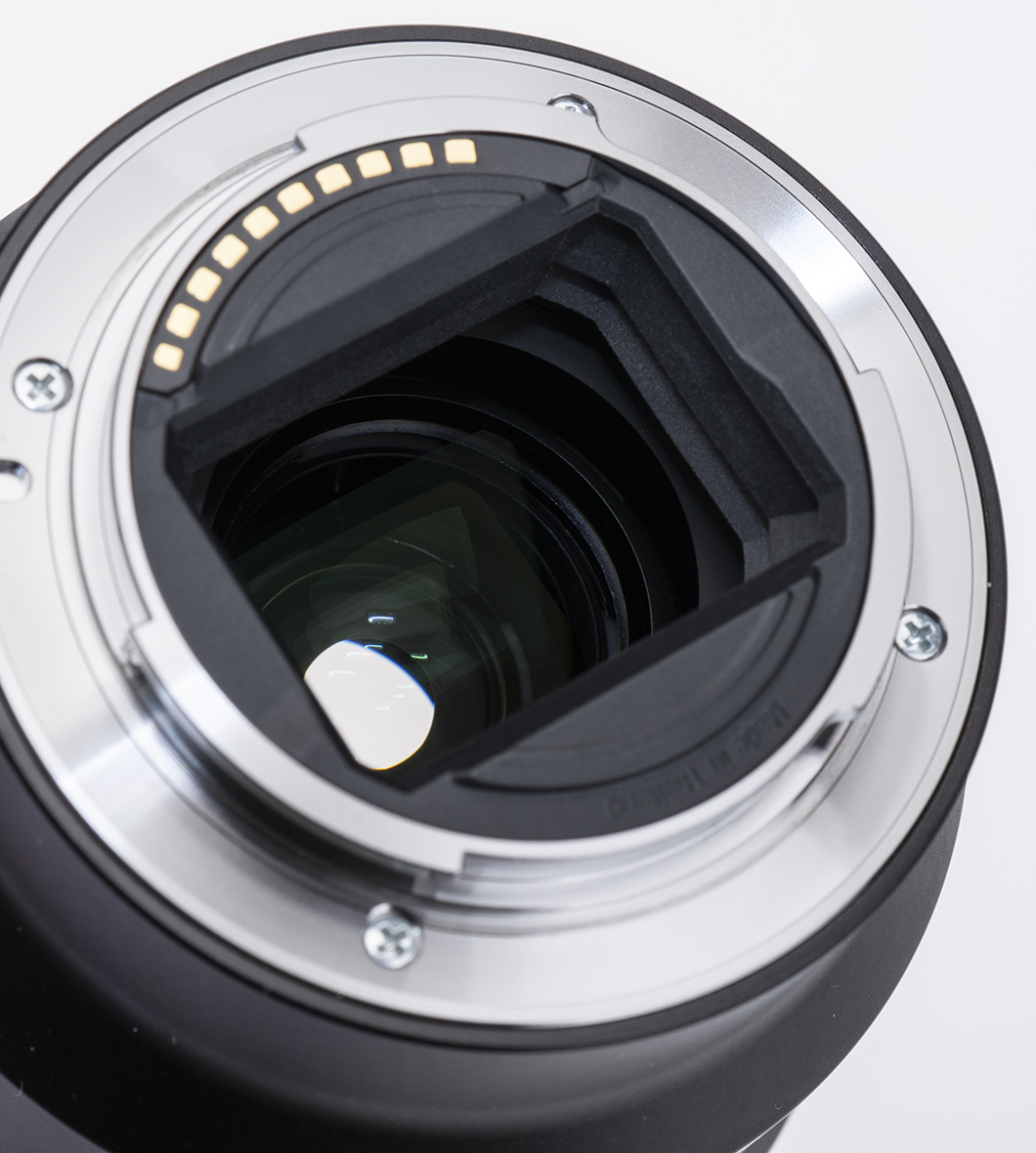
As to weather-sealing, since the lenses were retail stock and not Sony loan stock they were kept well away from rain. There is no gasket ring on the lens mount, which looks physically identical to the 70-300mm f/4.5-5.6 G OSS tele-zoom.

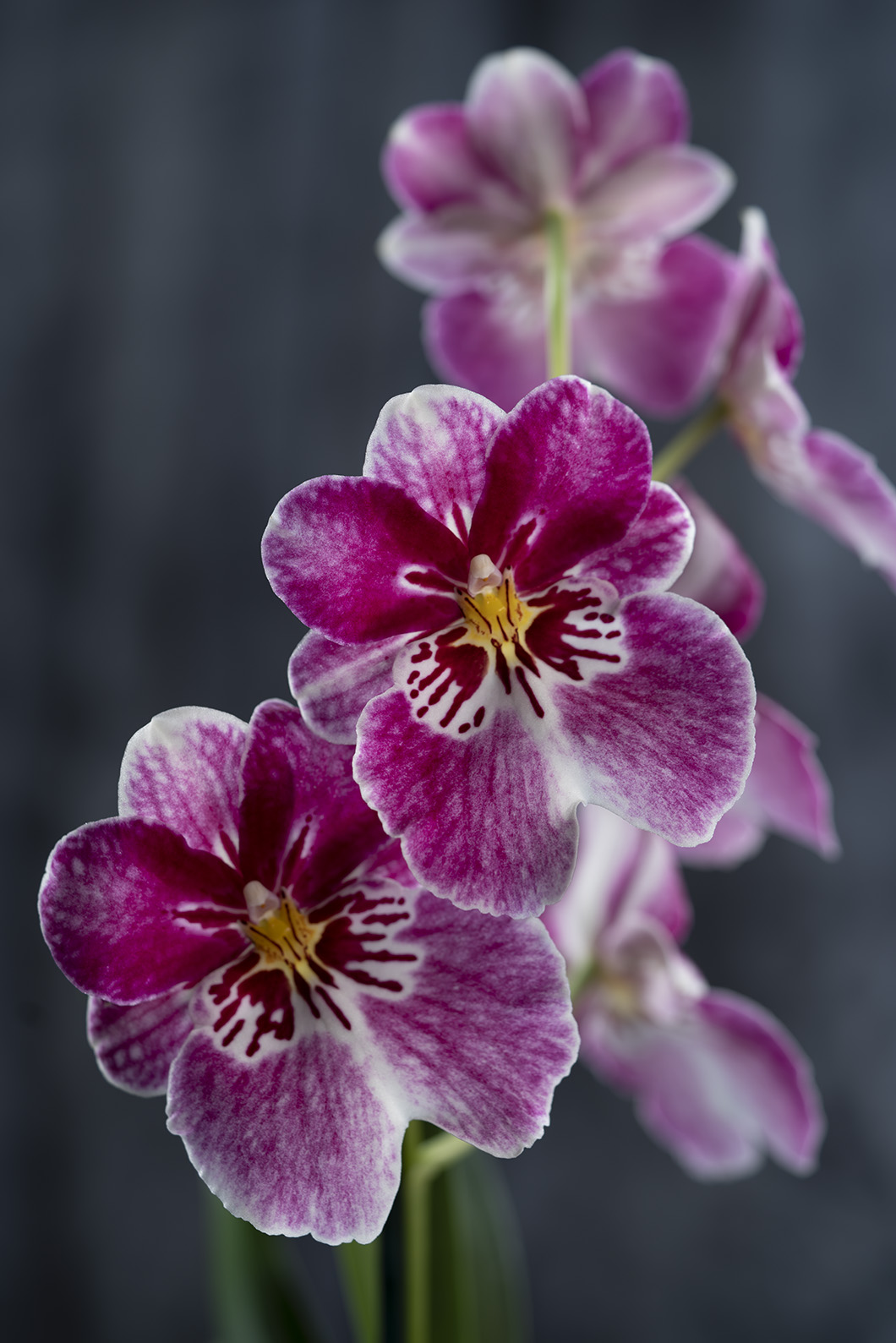
I can’t fault the 90mm AF performance in normal conditions, keeping track of moving targets like running dogs and waterfowl using wide area focus, AF-C and object tracking. The silent very fast autofocus is good for video as well as stills. For some into-the-light shots over water AF failed but this was low, clear winter sun blinding the camera and photographer alike. When placing the subject right in the brightest area, the hit rate fell to only 50%. Flare is negligible.

In MF mode, the focus by wire action has much the same smooth resistance as the A-mount macro but allows far finer control. It also invokes the magnified view (if set) with just the right sensitivity to nudging the focus.
Overall, it’s a lovely lens design and has all the functions and ‘feel’ you could want as a general short telephoto, portrait lens and macro. If the optical performance resembled the Voigtländer 110mm it would be a winner. In fact, if the results resembled the 100mm A-mount without the full aperture softness and chromatic aberration it would be great. Perhaps the complexity of 1:1 fast internal AF, plus OSS, demands standards of assembly and QC which were not met in either of the lenses I bought and returned.
Sticking with the old glass
After lens number two I called it a day, LCE had been an exemplary dealer and probably more help than a call out to Sony would have proved. Certainly, there’s no way I would buy a lens showing visible problems of this type and trust I could return it under warranty and get it fixed.
During tests, I found that my FE 50mm ƒ2.8 Macro and FE 85mm ƒ1.8 are both stunningly good performers, without any trace of decentred glass. Same for the Sigma 70mm ƒ2.8 DG ART Macro. I also confirmed that the Tamron FE 28-75mm DiIII RXD ƒ2.8 is similarly pin-sharp over most of the frame wide open. This was what I expected from the 90mm and simply didn’t get.
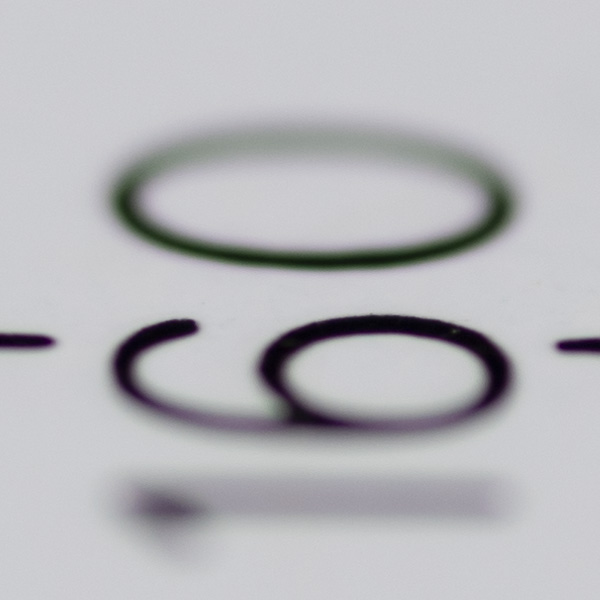
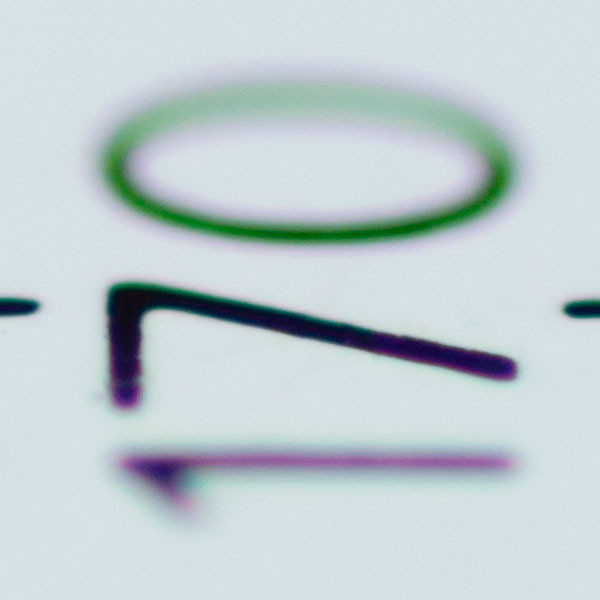
So soon after the lens went back, I found a new LA-EA4 at a really great price on offer and bought it. Fitting the 100mm SAL macro I was almost dreading the idea of slow, noisy AF. It was not. It was fast noisy AF, even with some distance to go and no pre-focusing near the subject. Just snap into focus, even in low light, hold focus with the shutter button first pressure and use peaking to fix the exact best focus plane while hand-holding and moving the camera slightly to fine tune focus. This is how I can work best with macro in the field, off a tripod.
It’s often still best to set MF (with the LA-EA3 MF is the only option). But getting out the A-mount kit then reminded me of other benefits. I have a good quality Kenko Teleplus MC7 DG 2X tele-converter, and it converts the 100mm into a 200mm ƒ5.6 2:1 macro. I also have A-mount extension tubes from the same maker, a substantial DG set giving me 12mm/20mm/36mm lengths or a combined additional extension of 58mm. My extension tubes for E-mount are just 10mm and 16mm, a total of 26mm which is not even enough to a 50mm lens to 1:1. I have bought two sets because one set is not really enough with longer focal lengths.

Mounting my Neewer LED Ring Flash, which doesn’t play all that well with E-mount aperture operation, the full aperture focusing and instant stop-down of the LA-EA4 and 100mm allowed me to get surprisingly good hand-held 2:1 shots with the converter at apertures of f/8 (above) and f/11, set to ISO 640 and with the flash at +1 power. Remember those are real apertures of f/32 and f/45, since the focus extension at 1:1 loses two stops and the converter loses two more.
If you own a trusted Canon or Sigma 100-105mm macro and you’re migrating to Sony full frame, do not sell your DSLR lens immediately – try a Sigma MC-11 or Metabones E-mount adaptor first.
Conclusion
Should you risk the 90mm given my experience? Chances are you will never use it for copying, architecture, landscape or anything which needs good performance across the field. You’ll shoot the same subjects normally seen in blogs and YouTube vlogs and most of these only need to be pin-sharp in the centre.
When lenses are returned as sub-standard Sony seems (from Facebook research!) to have a track record of confirming that the lens is up to specification and there’s nothing wrong with, or charging for a repair… and returning it without any improvement. So I would never accept a poor lens and hope to get this adjusted by Sony service, or confirmed as faulty and replaced.
I’ll give them the benefit of the doubt and assume that if I had ordered three, then four, maybe more replacement lenses I would have found one perfect example.
I think I will wait for a native E-mount new design Sigma 105mm f/2.8 macro – matching their 70mm – before I look for my next autofocus portrait/macro lens.
If I really want good easy macro, I use my Olympus OM-D E-M1 MkII with its 60mm f/2.8 M. Zuiko Macro and automatic focus stacking – on MFT’s small sensor, its 1:1 is equal to 2:1 on my full frame Sony and 20 megapixels is a far more sensible image size. Its 120mm equivalent field of view is ideal, it’s got excellent AF and good depth of field. It’s also very good for distant scenes. What it doesn’t have is Sony’s colour, dynamic range, high ISO quality and scope for cropping.
David Kilpatrick

I rather liked my A mount Sony 100 f2.8 macro. Certainly didn’t test it to extremes like yourself but it was a very nice lens, I just didn’t use it enough.
I had more use for longer telezooms, loved my 70-400G, built like a tank.